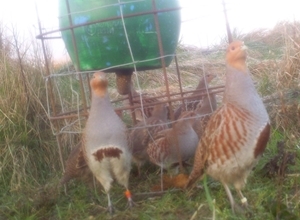 In many parts of Britain and Europe, modern farming practices are so efficient that very few seeds and weeds are left behind after harvesting. This leads to a lack of available food during winter, often referred to as the ‘hungry gap’, reducing the breeding success and survival of many farmland birds. Additionally, feeding is crucial for the management of released game. Reared pheasants and partridges need to familiarise with the feeding systems from early stages of life and correct location and density of feeders hold gamebirds in our shoots.
In many parts of Britain and Europe, modern farming practices are so efficient that very few seeds and weeds are left behind after harvesting. This leads to a lack of available food during winter, often referred to as the ‘hungry gap’, reducing the breeding success and survival of many farmland birds. Additionally, feeding is crucial for the management of released game. Reared pheasants and partridges need to familiarise with the feeding systems from early stages of life and correct location and density of feeders hold gamebirds in our shoots.
Our previous research has demonstrated that feeding during the ‘hungry gap’ keeps gamebirds in good body condition and increases seed-eating songbird densities. Thus, providing supplementary food for game and wildlife has become one of the most important management tools for game and wildlife conservation. As a result of our research, winter feeding became an option in the Entry Level Stewardship (ELS) scheme.
Why study the use of game feeders by wildlife?
Despite the undisputed benefits of feeders for gamebirds and songbirds, there has been no systematic study of the use of feeders by different species, especially non-desirable species that could take a high proportion of the grain given. Hence, in January 2012 we started a feeding experiment using motion-sensing cameras on several farmland sites of England during early and late winter.
How do we study game feeders?
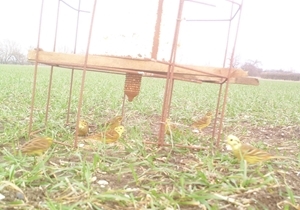 We use a basic feeder design, a grain drum with a spiral attachment, being held by a cage-like structure to reduce the use by deer and badgers. We study pairs of feeders within the home range of grey partridges, with one feeder set in cover along a hedgerow and another in an open field (winter wheat, rape or crops under 10cm of height). Additionally, we investigate the use of single feeders in open fields. Feeders are moved 25 metres from the original location to reduce the use by rats and every feeder is studied over a period of one week.
We use a basic feeder design, a grain drum with a spiral attachment, being held by a cage-like structure to reduce the use by deer and badgers. We study pairs of feeders within the home range of grey partridges, with one feeder set in cover along a hedgerow and another in an open field (winter wheat, rape or crops under 10cm of height). Additionally, we investigate the use of single feeders in open fields. Feeders are moved 25 metres from the original location to reduce the use by rats and every feeder is studied over a period of one week.
We identify which species visit feeders using camera traps, which are triggered by either heat or movement. The cameras are set to operate continuously day and night, so it is possible to identify which species are using hoppers at any given time, generating thousands of images. We also investigate the effects of hopper location on the attractiveness for game and other wildlife.
Key findings
- After the analysis of more than 145,000 photographs, our research has established these key findings:
- Feeders are used by gamebirds and songbirds but also by unwelcome pests (rodents, corvids and pigeons), even when proper control of predators is conducted.
- The majority of species prefer feeders along hedgerow cover in comparison with feeders located in open fields. Apart from rats, all species use feeders in open fields.
- Changing the feeder location regularly does not affect the use by gamebirds.
- A high proportion of grain can be consumed by pests.
- Gamebirds show two activity periods around the hoppers: dusk and dawn.
Figure 1 & 2: Overall percentage of photographs per group of species at two of our study sites
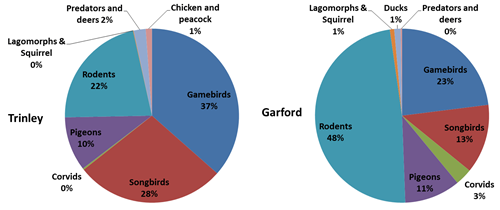
What happens if feeders are not managed correctly?
It is clear that when feeders are not managed correctly the presence of pests can increase dramatically. This not only implies food waste (in some cases up to 50% of the grain), but could also increase the predation of ground-nesting birds when rats and corvids are benefited by feeders.
How can we reduce the presence of pests in feeders?
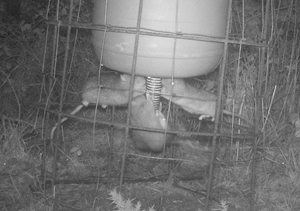 Our research has established these management implications to ensure the use of feeders by gamebirds and reduce the presence of pests:
Our research has established these management implications to ensure the use of feeders by gamebirds and reduce the presence of pests:
- Feeders located in open fields stops use by rats.
- When using feeders along hedges, changing their location regularly is highly recommended, as gamebirds are able to find and use feeders.
- Excluders help to reduce the use by deer and badgers which could destroy the feeder.
Our research is ongoing as we need to reduce the use of feeders by pests even more, through testing different feeder designs. We will then be in a position to encourage gamekeepers and conservationists to use the ideal type of feeder and location. This will provide the maximum conservation benefit for game and wildlife.
Get your FREE Grey Partridge Conservation Guide
An essential guide to conserving the grey partridge produced by the Game & Wildlife Conservation Trust.
What's inside your FREE guide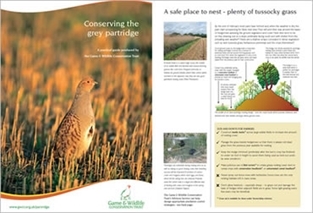
✓ The decline of a common farmland bird
✓ A safe place to nest - plenty of tussocky grass
✓ Chick survival - insect food is crucial
✓ Surviving winter and spring - food and cover
✓ Conservation targets - Partridge Count Scheme
✓ Grey partridges and shooting
✓ Common questions
Download guide now >